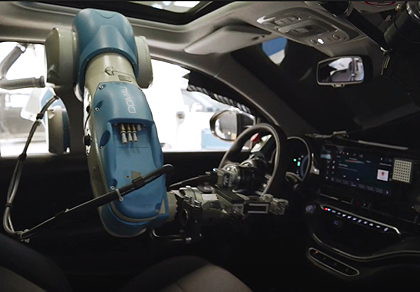- Home » News » Technology News
Piggyback robots test infotainment systems in Fiat 500 EVs

The Italian car-maker Fiat is using a pair of robots, combined with powerful AI-based software, to automate the testing of infotainment systems in its new all-electric Fiat 500 cars. Testing such systems has traditionally been a repetitive, time-consuming process carried out by human operators at a high cost and with a significant risk of errors.
The robotic test system uses a Racer5 cobot (collaborative robot) from the Italian robot-maker Comau – like Fiat, a member of the Stellantis conglomerate which was formed in 2021 by the merger of Fiat Chrysler with the French PSA Group. The cobot is mounted on the wrist of a safe version of Comau’s NJ-220 industrial robot and can enter the car body through a window to perform its tests.
Together, the pair of robots carry out automated testing inside the car, improving efficiency, traceability and repeatability compared to manual methods. The collaborative system also helps ensure compliance with the testing process by helping operators to complete each task. It uses sensors and other devices said to deliver “almost human” sensitivity. These include a vision system for validating infotainment apps, a microphone and speaker for recognising voice commands, and a gripper for performing delicate touching operations. The safety functions of the six-axis articulated cobot eliminate the need for protective barriers, allowing operators to be inside a car at the same time that the robot is carrying out its tests, as well as saving space and cutting safety costs.
Fiat is using an AI-based software program said to make man-machine communications easier, while optimising industrial operations. The software – called MI.RA/Dexter – is a metalanguage that makes robotics more accessible by translating human language syntax into robot syntax. This allows operators to program robotic systems easily using simple and intuitive controls – such as looking at an object, touching a specific point, listening to voice recognition operations, and executing complex actions. The operator can adapt, adjust and correct the actions of the robot in real time to optimise workcycle efficiencies.
The MI.RA (machine inspection and recognition archetypes) software avoids the need for IT or robotics expertise, thus cutting robot programming costs. It also helps to streamline the creation of complex programs for interacting with robotic arms, and could be used to program any industrial technology.

In the Fiat application, the programming language allows operators to manage the complex robotic system autonomously without needing to do any coding. This includes the safe management of actions that the cobot has can perform in close coordination with an operator, as well as the automation and subsequent optimisation of the testing tasks.
“With MI.RA/Dexter, complex technology becomes more accessible and less expensive thanks to the user-friendly software interface and metalanguage syntax,” says Comau’s chief innovation officer, Giovanni Di Stefano. “The intuitive system, which is based on AI algorithms and can be used in virtually any industrial sector, also allows real-time adjustment of process parameters for better operative quality and efficiency.”
Comau: Twitter LinkedIn Facebook





